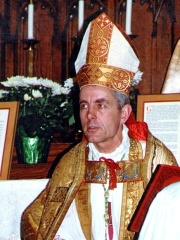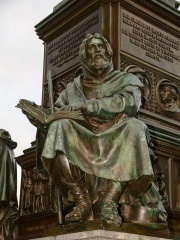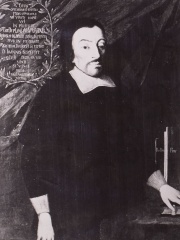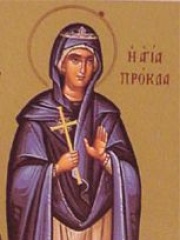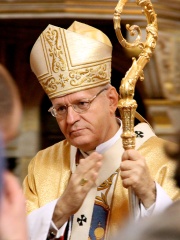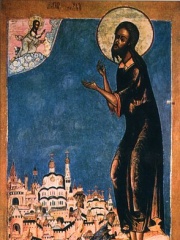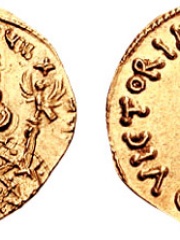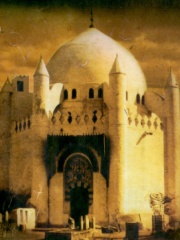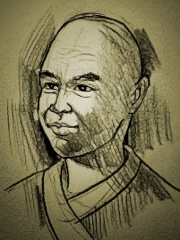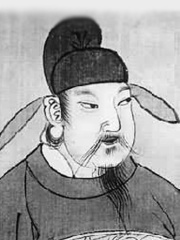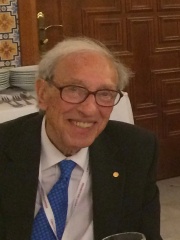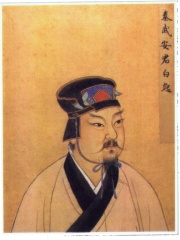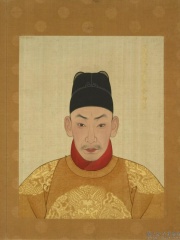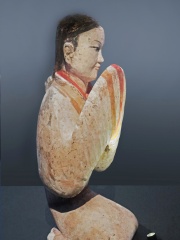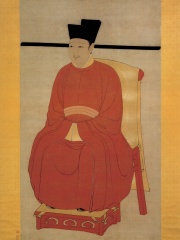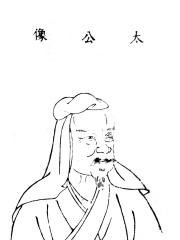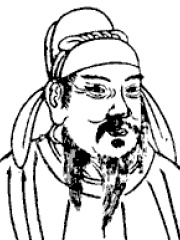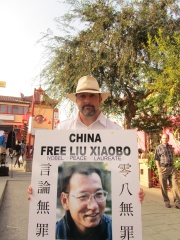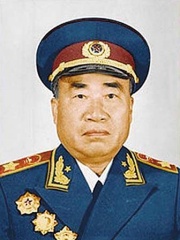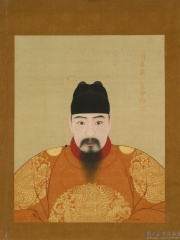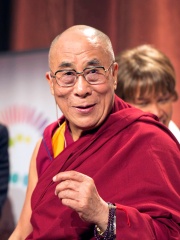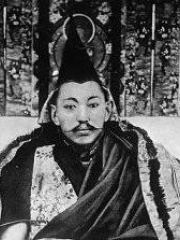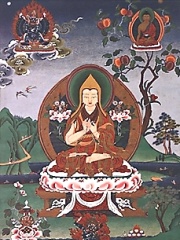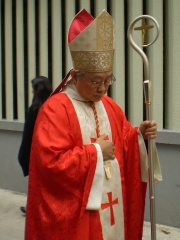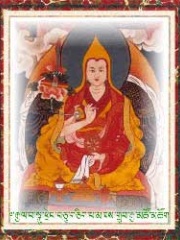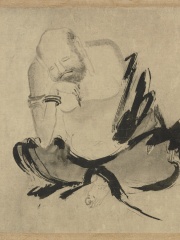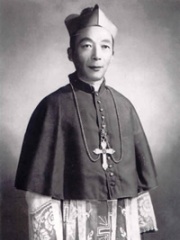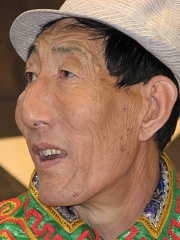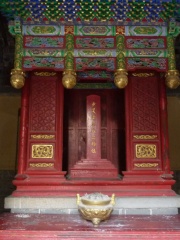Religious Figure
Huineng
638 - 713
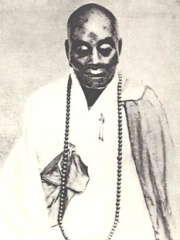
 Huineng
Huineng
Dajian Huineng or Hui-neng (traditional Chinese: 大鑒惠能; pinyin: Dàjiàn Huìnéng; Cantonese Jyutping: daai6 gaam3 wai6 nang4; Wade–Giles: Ta⁴-chien⁴ Hui⁴-nêng²; Japanese: Daikan Enō; Korean: Daegam Hyeneung; February 27, 638 – August 28, 713), also commonly known as the Sixth Patriarch or Sixth Ancestor of Chan (traditional Chinese: 禪宗六祖), is a semi-legendary but central figure in the early history of Chinese Chan Buddhism. According to tradition Huineng was an uneducated layman who suddenly attained awakening (Chinese: 見性, jianxing) upon hearing the Diamond Sutra. Despite his lack of formal training, he demonstrated his understanding to the fifth patriarch, Daman Hongren, who then supposedly chose Huineng as his true successor instead of his publicly known selection of Yuquan Shenxiu. Huineng is regarded as the founder of the "Sudden Enlightenment" Southern Chan school of Buddhism, which focuses on an immediate and direct attainment of Buddhist enlightenment. Read more on Wikipedia
His biography is available in 30 different languages on Wikipedia. Huineng is the 681st most popular religious figure (down from 609th in 2024), the 150th most popular biography from China (up from 156th in 2019) and the 3rd most popular Chinese Religious Figure.
Huineng is famous for his role in the development of the Chan (Zen) school of Buddhism and for his emphasis on the importance of direct experience in spiritual practice. Huineng is also known for his teachings on the nature of mind and consciousness, which emphasized the fundamental emptiness and impermanence of all phenomena. His teachings had a profound influence on the development of Buddhism in China and throughout East Asia.
Memorability Metrics
Page views of Huineng by language
Among Religious Figures
Among religious figures, Huineng ranks 681 out of 3,187. Before him are Richard Williamson, Peter Waldo, Angelus Silesius, Ja'far ibn Abi Talib, Pontius Pilate's wife, and John of God. After him are Abu Dhar al-Ghifari, Qasim ibn Muhammad, Al-Nasa'i, Péter Erdő, Alexius of Rome, and Muadh ibn Jabal.
Most Popular Religious Figures in Wikipedia
Go to all RankingsRichard Williamson
1940 - 2025
HPI: 71.07
Rank: 675
Peter Waldo
1140 - 1205
HPI: 71.06
Rank: 676
Angelus Silesius
1624 - 1677
HPI: 71.03
Rank: 677
Ja'far ibn Abi Talib
589 - 629
HPI: 71.03
Rank: 678
Pontius Pilate's wife
6 - 100
HPI: 71.03
Rank: 679
John of God
1495 - 1550
HPI: 71.02
Rank: 680
Huineng
638 - 713
HPI: 71.02
Rank: 681
Abu Dhar al-Ghifari
600 - 652
HPI: 71.01
Rank: 682
Qasim ibn Muhammad
598 - 600
HPI: 70.99
Rank: 683
Al-Nasa'i
829 - 915
HPI: 70.98
Rank: 684
Péter Erdő
1952 - Present
HPI: 70.94
Rank: 685
Alexius of Rome
400 - 412
HPI: 70.91
Rank: 686
Muadh ibn Jabal
600 - 640
HPI: 70.91
Rank: 687
Contemporaries
Among people born in 638, Huineng ranks 1. Among people deceased in 713, Huineng ranks 3. Before him are Philippikos Bardanes, and Ali ibn Husayn Zayn al-Abidin. After him are Yijing, Princess Taiping, and Ealdwulf of East Anglia.
Others Born in 638
Go to all RankingsOthers Deceased in 713
Go to all RankingsPhilippikos Bardanes
POLITICIAN
700 - 713
HPI: 77.33
Rank: 1
Ali ibn Husayn Zayn al-Abidin
RELIGIOUS FIGURE
659 - 713
HPI: 76.32
Rank: 2
Huineng
RELIGIOUS FIGURE
638 - 713
HPI: 71.02
Rank: 3
Yijing
RELIGIOUS FIGURE
635 - 713
HPI: 67.50
Rank: 4
Princess Taiping
COMPANION
665 - 713
HPI: 66.68
Rank: 5
Ealdwulf of East Anglia
NOBLEMAN
700 - 713
HPI: 50.36
Rank: 6
In China
Among people born in China, Huineng ranks 150 out of 1,610. Before him are Emperor Ruizong of Tang (662), Edmond H. Fischer (1920), Bai Qi (-250), Zhengde Emperor (1491), Empress Lü (-241), and Emperor Huizong of Song (1082). After him are Jiang Ziya (-1090), Emperor Zhongzong of Tang (656), Chenghua Emperor (1447), Liu Xiaobo (1955), Zhu De (1886), and Hongzhi Emperor (1470).
Others born in China
Go to all RankingsEmperor Ruizong of Tang
POLITICIAN
662 - 716
HPI: 71.23
Rank: 144
Edmond H. Fischer
CHEMIST
1920 - 2021
HPI: 71.19
Rank: 145
Bai Qi
MILITARY PERSONNEL
250 BC - 257 BC
HPI: 71.18
Rank: 146
Zhengde Emperor
POLITICIAN
1491 - 1521
HPI: 71.08
Rank: 147
Empress Lü
POLITICIAN
241 BC - 180 BC
HPI: 71.03
Rank: 148
Emperor Huizong of Song
POLITICIAN
1082 - 1135
HPI: 71.02
Rank: 149
Huineng
RELIGIOUS FIGURE
638 - 713
HPI: 71.02
Rank: 150
Jiang Ziya
POLITICIAN
1090 BC - 1015 BC
HPI: 70.98
Rank: 151
Emperor Zhongzong of Tang
POLITICIAN
656 - 710
HPI: 70.97
Rank: 152
Chenghua Emperor
POLITICIAN
1447 - 1487
HPI: 70.94
Rank: 153
Liu Xiaobo
SOCIAL ACTIVIST
1955 - 2017
HPI: 70.93
Rank: 154
Zhu De
POLITICIAN
1886 - 1976
HPI: 70.91
Rank: 155
Hongzhi Emperor
POLITICIAN
1470 - 1505
HPI: 70.82
Rank: 156
Among Religious Figures In China
Among religious figures born in China, Huineng ranks 3. Before him are 14th Dalai Lama (1935), and 13th Dalai Lama (1876). After him are Je Tsongkhapa (1357), Yijing (635), Joseph Zen (1932), 11th Dalai Lama (1838), Dazu Huike (487), Ignatius Kung Pin-Mei (1901), Bao Xishun (1951), Shaohao (null), and Rabban Bar Sauma (1220).
14th Dalai Lama
1935 - Present
HPI: 83.17
Rank: 1
13th Dalai Lama
1876 - 1933
HPI: 73.53
Rank: 2
Huineng
638 - 713
HPI: 71.02
Rank: 3
Je Tsongkhapa
1357 - 1419
HPI: 70.56
Rank: 4
Yijing
635 - 713
HPI: 67.50
Rank: 5
Joseph Zen
1932 - Present
HPI: 66.29
Rank: 6
11th Dalai Lama
1838 - 1856
HPI: 65.48
Rank: 7
Dazu Huike
487 - 593
HPI: 65.13
Rank: 8
Ignatius Kung Pin-Mei
1901 - 2000
HPI: 64.38
Rank: 9
Bao Xishun
1951 - Present
HPI: 64.37
Rank: 10
Shaohao
HPI: 63.86
Rank: 11
Rabban Bar Sauma
1220 - 1294
HPI: 63.40
Rank: 12
